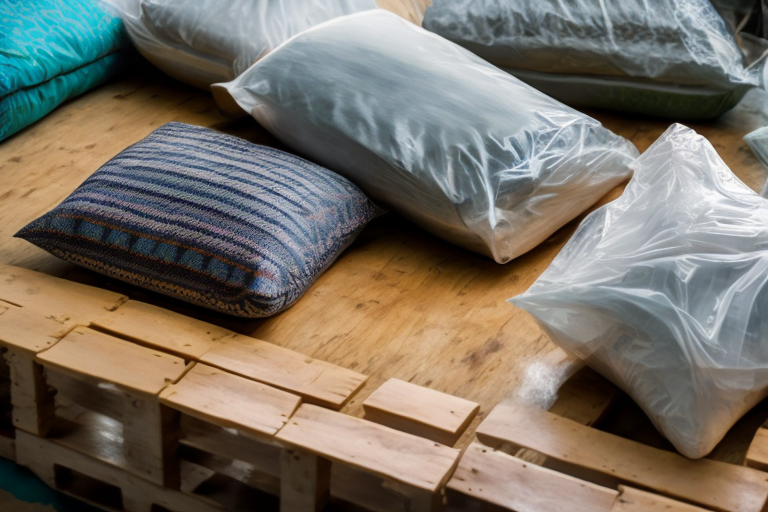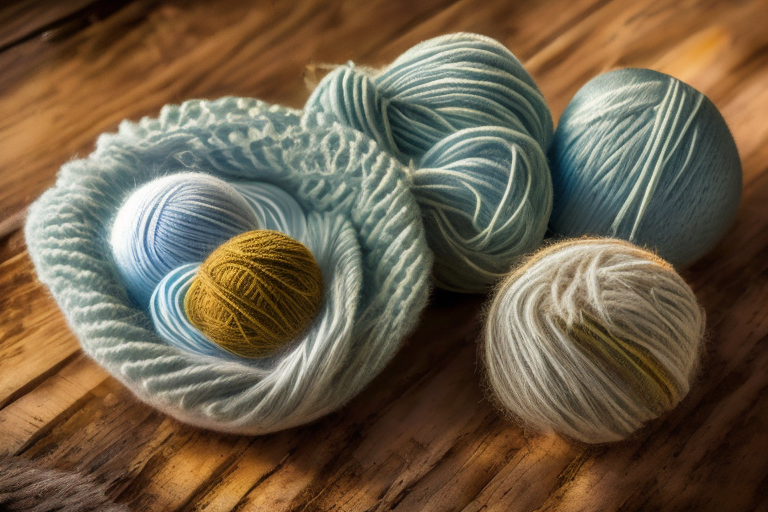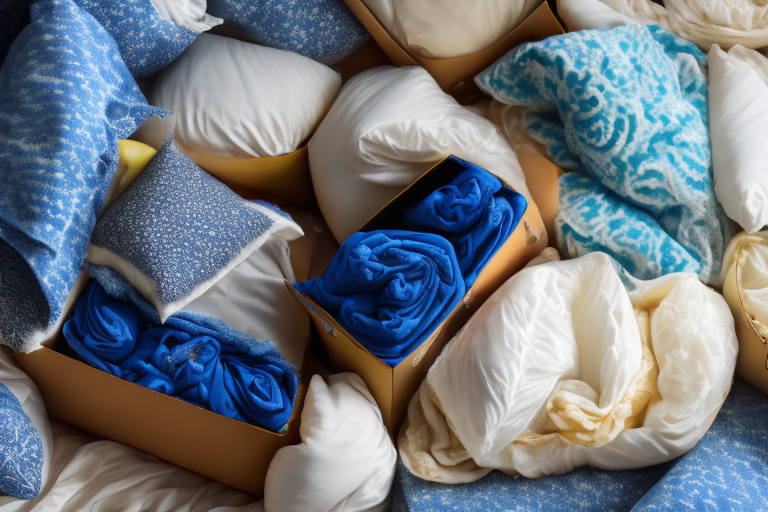Down comforters are a popular bedding choice due to their lightweight warmth and plush feel. But what happens when it’s time to replace your down comforter? Is recycling or repurposing an option? This beginner’s guide covers everything you need to know about sustainably managing down comforters at the end of their lifespan.
What Are Down Comforters?
Before diving into recycling, let’s review what exactly down comforters are. Down comforters are filled with the fluffy underside feathers from ducks or geese that provide exceptional insulation and loft. The outer fabric shell traditionally consists of cotton, but some modern down comforters feature an outer shell made from materials like Egyptian cotton or Egyptian cotton.
Why Consider Recycling Down Comforters?
With the average lifespan of a down comforter ranging from 10 to 15 years with proper care, most households eventually face the decision of what to do with down bedding that reaches end-of-life. Some key reasons why recycling and repurposing should be considered are:
- Textile waste: Over 85% of textiles end up in landfills in the US rather than being recycled or repurposed. Finding alternative solutions diverts waste.
- Sustainability: Recycling and repurposing extends the lifecycle of products rather than purchasing new items. This reduces the environmental impact.
- Creative possibilities: Old down comforters present unique opportunities for creative transformations into new household items or donation to good causes.
Signs It’s Time to Replace Your Down Comforter
When searching for recycling and repurposing solutions, the first step lies in identifying when your down comforter has reached the point for replacement. Here are the top signs to look out for:
- Visible holes, tears, or rips in the outer fabric shell
- Significant clumping or loss of fluffiness of the down fill
- Persistent odors that resist cleaning attempts
- Discoloration that cannot be removed through washing
- Presence of live insects or evidence of insects
Ethical Sourcing of Down Fill
An important consideration surrounding down bedding is the ethical sourcing of materials. Ethical down means the feathers are harvested humanely from already slaughtered ducks and geese during food production rather than exploiting live birds solely for their down fill through controversial techniques like live-plucking.
When purchasing new down comforters, look for certifications like the Responsible Down Standard to ensure ethical treatment within manufacturing processes.
Repurposing Down Comforters Through Donation
One method for extending the lifecycle of a down comforter no longer usable on the bed lies in donation. Charitable organizations often accept used down bedding to support various causes.
Donation Opportunities
- American Textile Recycling Service (ATRS): This organization supports US veterans by recycling used textiles into housing insulation and sells remnants as wiping rags to enterprises needing these materials.
- Natural disaster relief agencies: Local Goodwill or Salvation Army branches along with organizations like the Red Cross often send used bedding to provide aid after floods, fires, and other emergencies leaving victims in need.
Donation Standards
When donating down comforters, bedding should be freshly washed, dry, and contained in sealed bags to avoid concerns surrounding cleanliness, odors, or potential insect infestations. Stained, ripped, or otherwise damaged bedding may still qualify for programs using textiles for recycling into insulation or rags depending on the organization’s needs and policies.
Repurposing Down Comforters at Home

With some creativity, down comforters ready for retirement from the bedroom present unique opportunities for transformation into new household items or practical uses leveraging the ultra-warm down insulation.
Ideas for Repurposing Down Comforters
- Outdoor gear like jackets or sleeping bags
- Pet beds to provide warmth and comfort
- Inserts for floor cushions or specialty pillows
- Stuffed toys filled with fluffy down instead of synthetic stuffing
- Draft blockers for doors and windows to seal out cold air
Almost any application benefiting from a warm, lightweight fill can incorporate recycled down comforter materials. Tap your creativity to identify new uses rather than sending old bedding to the landfill.
The Role of Textile Recycling Companies
In addition to donation centers and home repurposing, partnering with textile recycling companies offers another avenue for responsibly managing down comforters that reach end-of-life. These specialized enterprises process used textiles in an environmentally-friendly manner.
Recycling Centers and Down Bedding
While some recycling centers specialize in apparel and clothing, a few niche organizations focus specifically on down and feather products:
- American Down & Feather Council: Provides listings of recycling options in the US and Canada to responsibly repurpose down bedding once it reaches end-of-use.
- Allied Feather & Down: Runs recycling programs in both the United States and Canada to reuse down and feathers. Materials become fill for new pillows, comforters, apparel, furniture, and more.
Environmental Impact
Recycling one ton of textile waste equals:
- 30% reduction in carbon emissions
- 40% reduction in water usage
- 38% reduction in fertilizer use
- 35% reduction in dyeing process chemicals
By leveraging recycling instead of landfill disposal, individuals and businesses take an active role in reducing environmental footprints. Even small comforters create meaningful impacts at scale.
Second-Hand Down Comforters
For those seeking budget-friendly options or wanting to minimize environmental footprints, the second-hand marketplace offers opportunities for obtaining down bedding.
Sourcing Pre-Loved Down Comforters
Venues to find second-hand down comforters include:
- Online platforms like craigslist, eBay, and Facebook Marketplace
- Consignment stores and thrift shops
- Yard sales, estate sales, and classified ads
When sourcing pre-used down bedding:
- Inspect carefully for any signs of damage, excessive wear, stains, or odors
- Ask about the comforter’s origins and age to estimate remaining lifespan
- Launder before use according to manufacturer guidelines
Second-Hand Market Impact
The second-hand market for household goods and clothing presents a prime avenue for reducing landfill waste. Benefits include:
- Redirects items from landfills by promoting reuse
- Provides affordable options for shoppers needing household goods
- Embodies principles of the circular economy through repeated use cycles
Health and Hygiene Considerations
When dealing with used bedding of any type, health and hygiene require consideration before reuse to prevent safety issues.
Hygiene Hazards
Potential hygiene hazards used down bedding may pose without proper handling include:
- Infestations from bed bugs, lice, or carpet beetles if pests are present
- Growth of mold, fungi, or mildew if stored damp
- Bacteria that causes respiratory irritation or infection
- Allergens like pollen, dust mites, feathers or animal dander
Mitigating Risks
To ensure health and safety, always take these precautions with second-hand down bedding:
- Inspect carefully for any signs of pests – discard immediately if found
- Check for odors or stains that may indicate contamination
- Wash and dry thoroughly on high heat before reuse
- For severe allergies, consider professional sanitation
Alternatives to Down Fill
While down earns its popularity through exceptional performance and comfort, some disadvantages do exist. Luckily alternatives provide comparable insulation.
Down Comforter Alternatives
Pros
Cons
| Fill Material | Pros | Cons |
|---|---|---|
| Synthetic (Polyester) | Affordable, hypoallergenic | Heavier, less insulating per ounce |
| Organic Wool | Renewable, compostable source | Expensive, prone to clumping |
| Organic Cotton | Breathable, compostable | Needs added batting for warmth |
| Hemp | Eco-friendly, moisture-wicking | Lower insulating value alone |
While no perfect substitution for down exists, alternative fill materials allow consumers to align decisions with personal priorities surrounding sustainability, ethics, allergy concerns, and performance needs.
Ethical and Sustainable Down

For consumers prioritizing natural materials but concerned regarding animal welfare, the market offers ethically-produced down options. Sustainable down means attentiveness to humane treatment as well as environmental impacts at all production stages.
Certifications
Look for these labels when sourcing ethical down:
- Responsible Down Standard (RDS): Certifies strict guidelines for animal welfare in down production.
- Global Recycled Standard (GRS): Denotes use of recycled materials diverted from landfills.
- Safe Quality Food (SQF): Validates sustainable and responsible farming practices.
The Down Recycling Process
To close the loop on down bedding production, specialized mechanical processes allow recycling of materials back into new consumer goods. This embodies circular economy ideals.
Down Cycling Technology
- Extreme heat: Sterilizes and prepares down for opening equipment
- Opener machine: Opens down cluster into individual plumes
- Shaker machine: Removes debris and cleans feathers
- Density separator: Grades fill according to cluster size and quality
This multi-step process transforms unusable bedding into recycled down ready for insertion into new products.
Going Beyond Recycling: Upcycling
Some forward-thinking companies like Beyond Down take the recycling process further through upcycling – converting discarded materials into goods higher in value, quality, and performance than the original items. For example, they supplement recycled down with new goose byproduct feathers. This innovative approach elevates down recycling.
Recycled Down End Uses
Once reprocessed, reused down feathers find myriad applications:
- Fill for new down comforters, pillows, jackets, etc.
- Furniture stuffing for cushions and upholstery
- Insulation for bedding, outerwear, shoes, accessories
- Components for acoustic panels and sound dampening
- Pet bed fill promising warmth and comfort
- Upholstery batting for ottomans, chairs, stools
These diverse products demonstrate recycled content adds value across industries.
Organic Fertilizers from Down Cycling
Instead of mechanical recycling, some reclaim down through natural biodegrading processes benefiting agricultural needs.
Creating Organic Fertilizer
Companies like Allied Feather convert down into nutrient-dense fertilizer through proprietary methods including:
- Grinding feathers
- Blending with compounds promoting decay
- Heating to pasteurize and sterilize
- Packaging for Bulk Distribution
This ready-made organic fertilizer substitutes well for typical synthetic and chemical varieties while nurturing plants naturally.
Benefits
- Stimulates microbial soil activity
- Releases nitrogen, phosphorous and potassium slowly
- Improves moisture retention properties
- Increases yields across diverse crops
Through innovative thinking, waste feathers transform into a valuable resource supporting regenerative agriculture.
The Carbon Footprint of Down
Making sustainable choices requires assessing the entire lifecycle impact of products. For down bedding, key considerations around carbon emissions exist.
Down Fill Carbon Footprint
- Farming and feed require fossil fuels
- Processing stages produce additional emissions
- Transportation mileage accumulates through shipping
Impact of Recycling
Recycling down comforters reduces the carbon footprint by:
- Eliminating manufacturing emissions to produce new fill
- Lowering transportation miles through local reprocessing
- Avoiding methane release if sent to landfills
Comparing Down and Synthetic Insulation
How do down and synthetic options compare when measuring environmental impacts?
| Impact Factor | Natural Down Fill | Synthetic Fill |
|---|---|---|
| Carbon Footprint | Higher due to agriculture | Lower due to manufacturing |
| Biodegradability | Yes | No |
| Recyclability | Limited options available | Typically not recycled |
| Expected Lifespan | Over 10 years | 5-8 years |
While down carries a higher baseline footprint, opportunities exist to recapture materials through recycling and reduce overall emissions. Synthetics conversely contribute to microplastics and landfill waste without current recycling solutions.
Biodegrading Down Comforters
In some jurisdictions across Canada and Europe, legislation now prohibits sending textiles to landfills and incinerators. What does this mean for down bedding disposal?
Industrial Composting
Some metropolitan areas offer combined recycling and composting programs accepting household textiles like down comforters. The materials break down at industrial facilities just like food scraps or yard waste.
At-Home Composting
Small-scale composting also works for down and feathers. By chopping bedding into pieces and mixing with nitrogen-rich greens and browns, you can create nutrient-dense soil amendments for gardens. Monitor internal temperatures to ensure adequate heat for safety.
Making Down Recycling Accessible
While robust systems exist for down recycling industry-wide, barriers remain for widespread consumer adoption. Actionable solutions include:
- Expanded public drop-off locations like retail take-back programs
- Clear labeling guiding proper recycling and composting
- Consumer education around responsible disposal options
Through collaboration across regulatory agencies, manufacturers, and recycling enterprises, infrastructure for sustainable down comforter end-of-life management can become mainstream.
Market Outlook: Demand for Recycled Down
As environmental awareness grows among consumers, brands respond by prioritizing eco-friendly materials – including recycled down.
Consumer Trends
Surveys reveal over 60% of consumers want apparel and bedding produced sustainably. Recycled down qualifies as a regenerative ingredient appealing to this expanding demographic.
Industry Projections
By 2030, the market value of recycled down materials forecasts to reach $152 million due to rising demand across industries like fashion, hospitality, healthcare, and automotive manufacturing.
This beginner’s guide summarizes key considerations surrounding down comforter recyclability and repurposing. By understanding available options and implementing responsible end-of-life practices, households play pivotal roles in reducing textile waste. Remember creativity and innovating thinking present nearly unlimited possibilities for recycling down bedding rather than selecting landfill disposal. With some research and effort, your old down comforter transforms into valuable materials benefitting new industries!
Frequently Asked Questions
What are some creative ways to repurpose my old down comforter?
Some creative ways to repurpose used down comforters instead of landfilling them include transforming them into outdoor gear like jackets or sleeping bags, pet beds to provide warmth and comfort, inserts for floor cushions or specialty pillows, stuffed toys filled with fluffy down instead of synthetic stuffing, or draft blockers for doors and windows to seal out cold air. With some sewing skills and imagination, the possibilities are endless!
Where can I donate my old down comforter?
If your down comforter still has some usable life left, consider donating it to charities like American Textile Recycling Service (ATRS) which supports US veterans by recycling used textiles, or local Goodwill/Salvation Army branches that often send used bedding to provide aid after natural disasters. Make sure donated bedding is freshly washed, dry, and contained in sealed bags.
How do I know if the down in a comforter was ethically sourced?
Look for certifications like the Responsible Down Standard (RDS) or Global Recycled Standard (GRS) when buying down products. The RDS confirms the down came from ducks and geese treated humanely. GRS means recycled materials were used. These labels indicate ethical sourcing practices.
What risks exist when reusing second-hand down bedding?
Health and hygiene hazards pose risks when using second-hand down bedding. Inspect carefully for bed bugs, mold/mildew, and odors. Discard immediately if signs of contamination exist. Launder thoroughly on high heat before reuse. For severe allergies, consider professional sanitation before bringing pre-used bedding into your home.
How does down recycling help the environment?
Recycling one ton of down bedding reduces carbon emissions by 30%, water usage by 40%, fertilizer use by 38%, and dye chemicals by 35% versus manufacturing new products. Recycling eliminates these impacts otherwise created during primary production. It also reduces landfill waste.
What kinds of products use recycled down?
Recycled down fills new bedding, furniture cushions, apparel insulation, pet beds, acoustic panels, upholstery batting, and more. Repurposed feathers add value across industries. Some companies even upcycle materials into higher quality, premium goods compared to the originals.
Why does down bedding get converted into fertilizer?
Natural biodegrading processes can transform feathers into rich, organic fertilizer that releases key nutrients like nitrogen and phosphorous slowly to nourish soils and stimulate microbial activity. This organic fertilizer substitutes well for synthetic chemical varieties. Recycled down put to use in gardens reduces waste.








